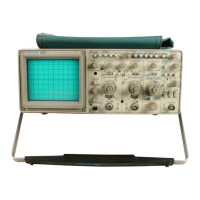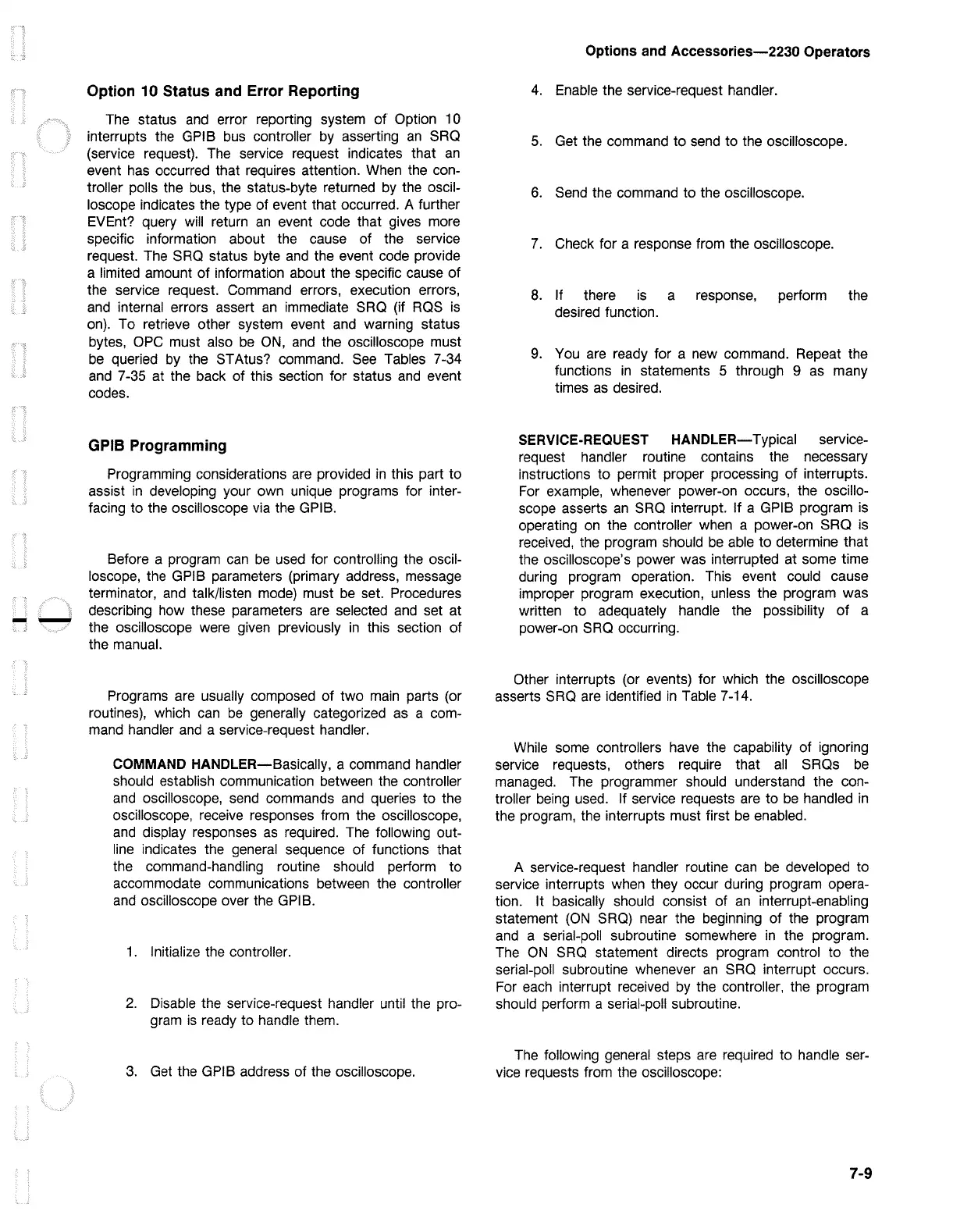--
Option 10 Status and Error Reporting
The
status
and
error reporting system
of
Option 10
interrupts
the
GPIB
bus
controller
by
asserting
an
SRO
(service request).
The
service request indicates that
an
event
has
occurred that requires attention.
When
the con-
troller polls the
bus,
the status-byte returned
by
the oscil-
loscope indicates the type of event that occurred. A further
EVEnt? query
will
return
an
event code that gives more
specific information about the cause of the service
request.
The
SRO
status byte
and
the event code provide
a limited amount of information about the specific cause of
the service request. Command errors, execution errors,
and
internal errors assert
an
immediate
SRO
(if
ROS
is
on).
To retrieve other system event
and
warning status
bytes,
OPC
must also
be
ON,
and
the oscilloscope must
be
queried
by
the STAtus? command.
See
Tables 7-34
and
7-35 at the back of this section for status
and
event
codes.
GPIB Programming
Programming considerations
are
provided
in
this part to
assist
in
developing your own unique programs for inter-
facing to the oscilloscope
via
the GPIB.
Before a program
can
be
used
for controlling the oscil-
loscope, the GPIB parameters (primary address, message
terminator,
and
talk/listen
mode)
must
be
set. Procedures
describing how these parameters
are
selected
and
set at
the oscilloscope were given previously
in
this section of
the manual.
Programs are usually composed of two
main
parts (or
routines), which
can
be
generally categorized
as
a com-
mand
handler
and
a service-request handler.
COMMAND HANDLER-Basically, a command handler
should establish communication between the controller
and
oscilloscope,
send
commands
and
queries to the
oscilloscope, receive responses from the oscilloscope,
and
display responses
as
required.
The
following out-
line
indicates the general sequence of functions that
the command-handling routine should perform to
accommodate communications between the controller
and
oscilloscope over the GPIB.
1.
Initialize the controller.
2.
Disable the service-request handler until the pro-
gram
is
ready to handle them.
3.
Get
the GPIB address of the oscilloscope.
Options and
Accessories-2230
Operators
4.
Enable the service-request handler.
5.
Get
the command to
send
to the oscilloscope.
6.
Send
the command to the oscilloscope.
7.
Check for a response from the oscilloscope.
8.
If there
is
a response, perform the
desired function.
9.
You
are
ready for a
new
command. Repeat the
functions
in
statements 5 through 9
as
many
times
as
desired.
SERVICE-REQUEST
HANDLER-
Typical service-
request handler routine contains the necessary
instructions to permit proper processing of interrupts.
For example, whenever power-on occurs, the oscillo-
scope asserts
an
SRO
interrupt. If a GPIB program
is
operating
on
the controller
when
a power-on SRO
is
received, the program should
be
able to determine that
the oscilloscope's power was interrupted at some time
during program operation. This event could cause
improper program execution, unless the program was
written to adequately handle the possibility
of
a
power-on
SRO
occurring.
Other interrupts (or events) for which the oscilloscope
asserts
SRO
are
identified
in
Table 7-14.
While
some controllers
have
the capability of ignoring
service requests, others require that
all
SROs
be
managed.
The
programmer should understand the con-
troller
being
used.
If service requests
are
to
be
handled
in
the program, the interrupts must first
be
enabled.
A service-request handler routine
can
be
developed to
service interrupts when they occur during program opera-
tion. It basically should consist of
an
interrupt-enabling
statement
(ON
SRO)
near the beginning of the program
and
a serial-poll subroutine somewhere
in
the program.
The
ON
SRO
statement directs program control to the
serial-poll subroutine whenever
an
SRO
interrupt occurs.
For
each
interrupt received by the controller, the program
should perform a serial-poll subroutine.
The
following general steps
are
required to handle ser-
vice requests from the oscilloscope:
7-9

